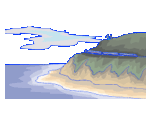 |
Gravity: Tidal Power
Tides
are the result of the Moon pulling on the oceans and seas. The rise and
fall of the sea surface has been used on a small scale for hundreds of
years.
Many large tidal schemes have been
proposed, but few ever built. One of the reasons being the adverse
environmental impact such schemes can have on local eco-systems. One
successful scheme is at La Rance, in northern France.
|
Using tidal power to generate electricity
A
barrage is built across the mouth of a bay. As the tide comes in,
sluice-gates in the barrage are opened to let the sea flood into the
bay. Once the tide outside has started to fall, the trapped water is
allowed to flow back into the sea, but it has to pass through turbines
built into the barrage. The turbines drive dynamos that generate
electricity.
Gravity: Water Power
The
gravitational attraction of the Earth pulls raindrops down to the
surface and then back to the sea. Energy can be extracted from the
water as it flows downhill. This can be used to turn machinery or to
generate electricity. |
 |
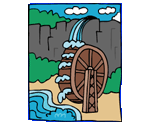 |
Old-fashioned
water mills use a wheel fitted with wooden paddles or odd-shaped
buckets to convert the energy of flowing water into a turning motion
that can drive machinery for such tasks as grinding corn and working
bellows.
|
Using water power to generate electricity
In
a hydro-electric power station (HEP station), large volumes of water
are stored in a reservoir behind a dam across a mountain valley. When
electricity is required, the water rushes downhill through a wide pipe
and into a turbine in the power station. It then escapes to a river.
The turbine is connected to a dynamo which generates electricity.
Wind Power
Winds are a free source of energy that have been exploited for at least three thousand years by …
|
 |
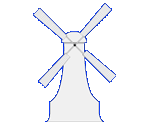 |
There
were once over 10,000 windmills across the UK. Most were used to pump
water from low-lying land or to grind corn into flour.
|
| Today
windmills have a different purpose; they produce electricity. Single
large wind turbines generate electricity to supply whole communities,
e.g. Shetland Islands, Swaffham (Norfolk). |
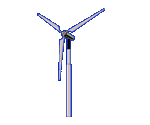 |
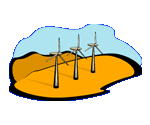 |
In
some places wind turbines are grouped together and known as wind farms.
They are built on exposed sites like the ridges of hills and mountains,
or offshore. They supply electricity to the national grid for use all
over the country.
|
| Smaller
wind turbines, often known as aero-generators, are used to charge
batteries for storing energy for use on boats, navigation buoys, remote
telephone boxes and even computers in schools. |
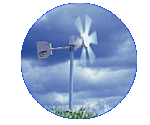 |
 |
Is there a working windmill, wind turbine or wind farm near you?
Can you arrange a visit?
What does it produce; flour, electricity, etc, or is it only a visitor attraction?
Who are its customers?
|
Wind Power Potential
The
UK is one of the windiest counties in Europe. Land-based wind-power
could generate up to 10% of the UK's electricity. This would require
38,000 wind-turbines. However it is highly unlikely these will ever be
achieved, as there are concerns about the noise and visual pollution of
wind-turbines in some rural environments. Offshore installations could
possibly make up the shortfall and the present UK Government is
committed to increasing this potential in the next few years.
|
|
|
|
Next page
|
 |
 |